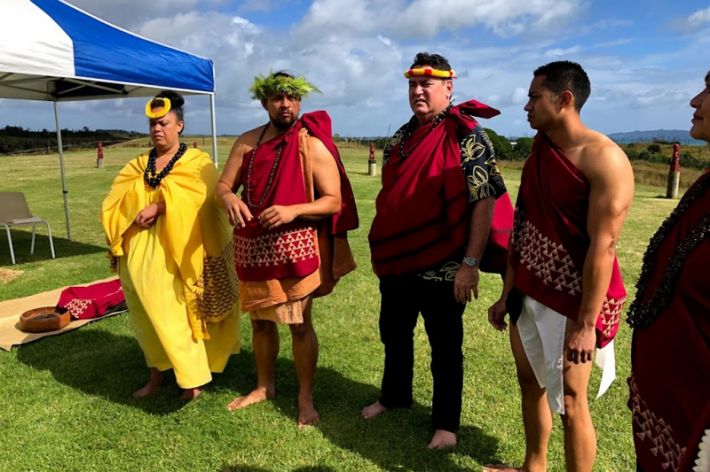This mo‘olelo is part of Kūkahekahe – Cultural Conversations – featuring personal experiences and insights from faculty and staff about compelling cultural happenings within the KS organization, throughout the Hawaiian Islands, and across the larger Pacific and global communities.
Did you know that the Ka‘iwakīloumoku Hawaiian Cultural Center at Kamehameha Schools Kapālama has a “sister center” under construction in Aotearoa (New Zealand)? The Sir Hek Busby Kupe Waka Centre is a school of traditional navigation and canoe-building scheduled to begin operation in fall 2021.
Kupe is the name of a revered Māori navigator who many believe discovered Aotearoa; waka is the Māori word for canoe, or waʻa in ʻōlelo Hawaiʻi; and of course, Sir Hek refers to none other than Sir Hector Hekenukumai Busby, master navigator, waka builder, and esteemed Māori elder who ignited the rebirth of Māori voyaging, and championed the founding of the Hawaiian tribe, Ngāti Ruawāhia following Hōkūleʻa’s historic voyage to Waitangi, Aotearoa in 1985 – navigated by Nainoa Thompson.
Over the past 35 years, more than 200 KS kumu and haumāna have made the pilgrimage to Waitangi and Aurere to honor and uphold the special Ngāti Ruawāhia tribal history and heritage. In fact, in December 2018, at the invitation of Uncle Hector, KS conducted ceremonies at Aurere to consecrate the umbilical connection between Uncle Hek’s outdoor star compass, kāpehu whetū, and our star compass, pānānā hōkū, located in the Hale Mana of Kaʻiwakīloumoku. This was followed by an ʻOki i Ka Piko ceremony, a Hawaiian piko-cutting ritual, to open the whare wānanga, a house of learning representing one part of a larger Kupe Waka Centre complex.
Hoʻokahua cultural consultants Manu Boyd KSK’80 and Snowbird Bento KSK’93 and Cultural Specialist Kaleonahe Kauahi-Daniels KSK’91 collected an array of beautiful native flora from Aurere, including the crimson red blossoms of the pōhutukawa, a species closely related to the Hawaiian ʻōhiʻa lehua. Together, they created a 20-foot lei designed to be suspended and hung straight down in front of the doorway to represent the piko, the umbilical cord of the new house.
Prior to the ceremony, the windows and doors of the hale (or whare in Māori – “wh” is a soft “f” sound and “r” is just slightly rolled) were completely sealed shut, and no one was allowed in or out. Community members gathered at the entrance of the building as Uncle Hek sat in his wheelchair quiet and pensive. KSK high school kumu hula Kaleo Trinidad KSK’93 held the lei piko in place while KSK Kumu ʻŌlelo Hawaiʻi Līhau Gouveia KSK’08, with his back against the front door of the house, held the block of wood upon which the lei piko would be cut.
“Uncle Hek was offering karakia (prayers), and as he called out the name of the house, ‘Whetū Mārama!’ and struck the lei piko with his toki (adze, koʻi in Hawaiian), a strong gust of wind seemed to exhale from inside the hale; so much so that the front doors actually blew open a bit and we had to lean back to hold them shut. It was like the hale taking its first breath,” Gouveia said.
“To see the house being born like that. It was powerful.” Kauahi-Daniels added, “I thought of the mele we do for Ngāti Ruawāhia, which has the line ‘Me ka hā nui, ka hā loa, ka hā hoʻomau.’” (And draw a deep and full breath – the persistent breath of life).
For Kauahi-Daniels, everything has come full circle. “The Pacific is us, it’s a ‘we,’ inclusive. I had been to Waitangi, Aotearoa in 1990 as a student with the delegation from Kamehameha. On this trip 30 years later, it’s like today’s kuleana is building upon the kuleana from the past, layered on top of one another. It reaffirmed for me that this is where I’m supposed to be – we are connected by our Pacific piko.”
__large-article__www-width-710/jpeg/3350)
Ngāti Ruawāhia members from Kamehameha Schools and the Polynesian Voyaging Society, and the Māori community gather in front of Whetū Mārama in 2018. The lei piko hangs at the entrance.

Snowbird Bento, Lāiana Kanoa-Wong, Manu Boyd and Līhau Gouveia prepare for the ceremony at the kapehu whetū, the star compass at Aurere, Aotearoa.

Māori master navigators Jacko Thatcher and Sir Hekenukumai Busby prepare for the ʻOki i ka Piko Ceremony. Vince Keala Lucero of Co-Creative Studios stands in the background.
TAGS
kūkahekahe,
cultural conversations,
ho'okahua,
hawaiian culture,
aotearoa,
sir hector busby
CATEGORIES
Kaipuolono Article, Regions, Themes, Culture, Community, Leadership, Hawaii Newsroom, KS Hawaii Home, Outreach, Kapalama Newsroom, Kapalama Home, Maui Newsroom, KS Maui Home, Newsroom, Campus Programs, Hawaii, Kapalama, Maui, Department News, Ho‘okahua, Mālama Honua
Print with photos
Print text only










